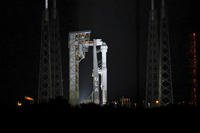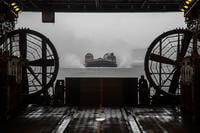 That's the only way I can describe the two armored vehicles that were hogging the right lane of I-26 outside Charleston, S.C. this weekend. They were early examples of the ULTRA AP -- "AP" for "Armored Patrol" -- a Humvee replacement being developed by Georgia Tech for the U.S. Marine Corps. The ones I saw were presumably on their way to the Navy lab in Charleston.
That's the only way I can describe the two armored vehicles that were hogging the right lane of I-26 outside Charleston, S.C. this weekend. They were early examples of the ULTRA AP -- "AP" for "Armored Patrol" -- a Humvee replacement being developed by Georgia Tech for the U.S. Marine Corps. The ones I saw were presumably on their way to the Navy lab in Charleston.
"The ULTRA AP will emphasize high-output diesel power combined with revolutionary armor and a fully modern chassis," according to Georgia Tech Research News. But never mind all that. The key difference between the ULTRA AP and the Humvee, and the reason the ULTRA needs a new engine and chassis at all, is that the new vehicle is wrapped in enough steel and ceramic to withstand all but the biggest IEDs. Experience in Iraq, where IEDs are the major killer, has proved that the battlefield of the future is no place for thin-skinned vehicles. In fact, the two newest additions to the Army's vehicle fleet, the Meerkat and the Buffalo (pictured below), are both designed for maximum protection against IEDs.
Now FCS has been redesigned to cope with dense urban environments and sophisticated IEDs. ULTRA AP, Meerkat and Buffalo have given us a glimpse of the future, where ground combat vehicles are as heavy as ever, if not heavier.
The big question? How do we get these big, heavy vehicles into the fight quicker?
--David Axe
Humvees on Crack
© Copyright 2024 Military.com. All rights reserved. This article may not be republished, rebroadcast, rewritten or otherwise distributed without written permission. To reprint or license this article or any content from Military.com, please submit your request here.







